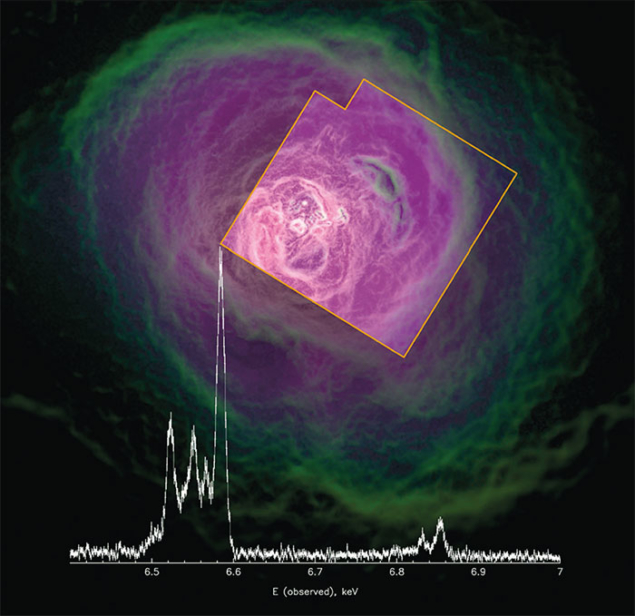
Image credit: NASA/CXO and Hitomi Collaboration.
With its very first observation, Japan’s Hitomi X-ray satellite has discovered that the gas in the Perseus cluster of galaxies is much less turbulent than expected. The unprecedented measurement opens the way towards a better determination of the mass of galaxy clusters, which has important cosmological implications.
Hitomi, which translates to “pupil of the eye”, is an X-ray observatory built and operated by the Japanese space agency (JAXA) in collaboration with more than 60 institutes and 200 scientists and engineers from Japan, the US, Canada and Europe. Launched on 17 February this year, Hitomi functioned for just over a month before operators lost contact on 26 March, when the spacecraft started to spin very rapidly, leading to its partial disintegration. It was a tragic end to a very promising mission that would have used a micro-calorimeter to achieve unprecedented spectral resolution in X-rays. Cooled down to 0.05 K, the soft X-ray spectrometer (SXS) was designed to record the precise energy of each incoming X-ray photon.
The cluster gas has very little turbulent motion
Hitomi targeted the Perseus cluster just a week after it arrived in space to measure the turbulence in the cluster to a precision of 10 km s–1, compared with the upper limit set by XMM-Newton of 500 km s–1. The SXS micro-calorimeter met expectations and measured a velocity of only 164±10 km s–1 along the line-of-sight. This low velocity came as a surprise for the Hitomi collaboration, especially because at the core of the cluster lies the highly energetic active galaxy NGC 1275. It indicates that the cluster gas has very little turbulent motion, with a turbulent pressure being only four per cent of the heat pressure of the hot intra-cluster gas. This is extraordinary, considering that NGC 1275 is pumping jetted energy into its surroundings to create bubbles of extremely hot gas.
Previously, it was thought that these bubbles induce turbulence, which keeps the central gas hot, but researchers now have to think of other ways to heat the gas. One possibility is sound waves, which would allow energy to be spread into the medium without global movement of the gas. The precise determination of the turbulence in the Perseus cluster allows a better determination of its mass, which depends on the ratio of turbulent to quiescent gas. Generalising the result of an almost negligible contribution of turbulent pressure in the central core of galaxy clusters impacts not just cluster physics but also cosmological simulations.
The impressive results of Hitomi only reinforce astronomers’ sense of loss. As this and several missions have shown, equipping an X-ray satellite with a micro-calorimeter is a daunting challenge. NASA’s Chandra X-ray Observatory, which launched in 1999, dropped the idea due to budget constraints. JAXA took over the calorimeter challenge on its ASTRO-E spacecraft, but the probe was destroyed in 2000 shortly after rocket lift-off. This was followed by the Suzaku satellite, launched in 2005, in which a leak in the cooling system destroyed the calorimeter. This series of failures is especially dramatic for the scientists and engineers developing such high-precision instruments over two decades – especially in the case of Hitomi, for which the SXS instrument worked perfectly until the loss of the satellite due to problems with the attitude control. Researchers may now have to wait more than a decade to use a micro-calorimeter in space, until ESA’s Athena mission, which is tentatively scheduled for launch in the late 2020s.







